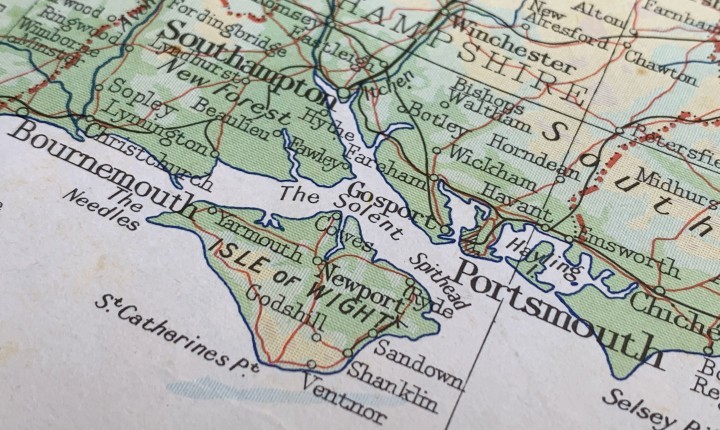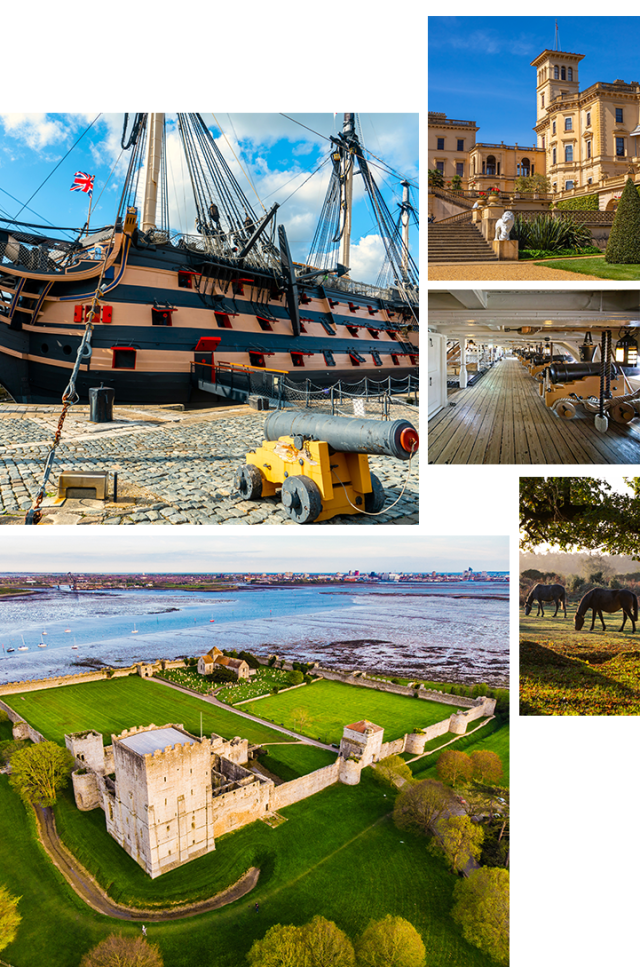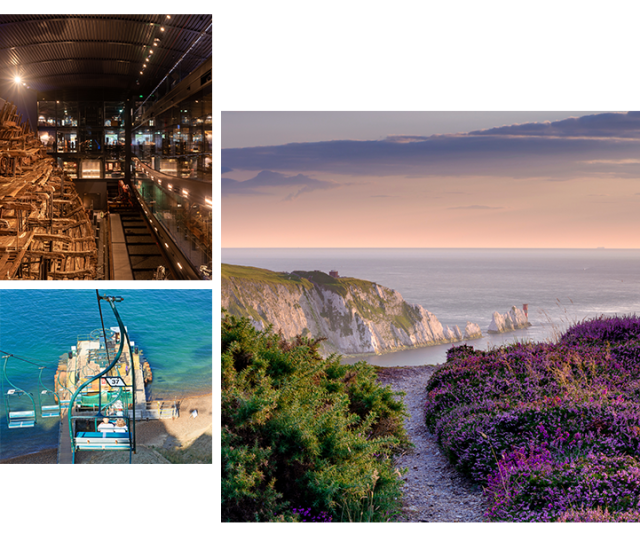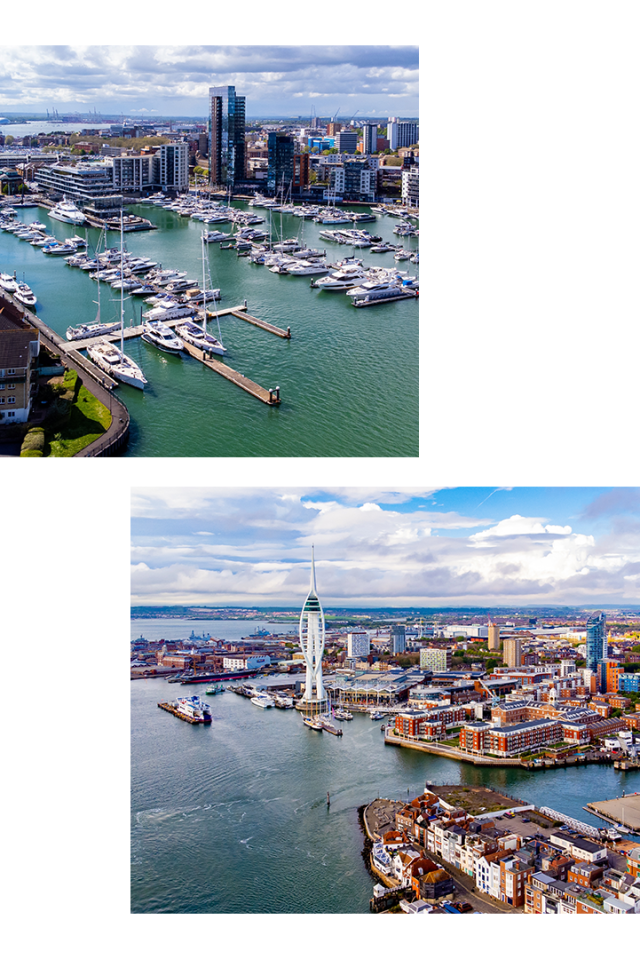Search Listings
Search Listings

The Solent region is steeped in maritime history, with its ports, waterways, and coastal landscapes playing a pivotal role in trade, tourism, and cultural heritage.

The Solent region encompasses the geographical areas surrounding the Solent Strait, a 20-mile-long waterway separating the northern shores of the Isle of Wight from mainland England.
Covering approximately 600 square miles and featuring 241 miles of coastline, this South Coast cluster extends from Barton-on Sea through to the New Forest. It includes the key cities of Southampton and Portsmouth, market towns such as Fareham and Gosport, and the Isle of Wight itself.

Once a river valley during the prehistoric period, the Solent region has been home to human settlements as early as the Stone Age, with remnants of an 8,000-year-old Mesolithic structure having been uncovered at Bouldnor Cliff, Isle of Wight.
Due to its strategic location, the Solent’s shores have long been vital for defence. The Romans recognised this potential and established forts such as Portchester Castle, which likely supported the Classis Britannica naval fleet. In later centuries, the Saxons and Normans repurposed and reinforced these fortifications, with Portchester Castle remaining a significant stronghold throughout the medieval period.
The Solent’s maritime legacy flourished during the Medieval Age and the following Age of Sail. Henry VII revolutionised naval infrastructure by constructing the first dry dock, in Portsmouth in 1495, with the city becoming England’s first permanent naval base.
Southampton emerged as a trade hub during the medieval era, exporting wool, cloth, and other goods, whilst Portsmouth went on to build iconic ships, such as the Mary Rose in the 16th century and HMS Victory in the 18th, both symbols of Britain's naval power.
The Industrial Revolution transformed the Solent region, introducing steam-powered ships, new shipbuilding techniques, and expanding its naval and trade infrastructure. Southampton became a centre for passenger shipping, notably being linked to the Titanic.
Improved rail networks and Victorian travel trends laid the foundation for the Solent area’s rise as a popular tourist destination. The Isle of Wight made a name for itself as a fashionable retreat, epitomised by Queen Victoria’s Osborne House, while the New Forest gained recognition for its natural beauty.
During both World Wars, the Solent region was a main player in Britain’s defence strategy. Portsmouth’s naval base supported D-Day preparations, while Southampton served as a key port for military logistics and troop deployment. The region, including smaller market towns such as Fareham and Gosport, was also used for testing new naval technologies, including radar and weapons systems.

Portsmouth showcases the region’s maritime heritage through the Historic Dockyard’s iconic ships and the D-Day Story museum’s retelling of the landings. Southampton also has its own SeaCity Museum, exhibiting the city’s role in trade and shipbuilding, including its connection to the Titanic.
In addition to Portchester Castle, visitors can explore the Solent’s various historical sites such as Henry VIII’s seaside forts: Hurst and Calshot castles.
On the Isle of Wight, Carisbrooke Castle tells the story of King Charles I’s imprisonment, while Osborne House offers a glimpse into Victorian grandeur, with stunning gardens and views. The island also boasts scenic coastal landmarks like the Needles and Alum Bay, also making it ideal for outdoor recreation.
Arguably the most picturesque location in the region is the New Forest. Once William the Conqueror’s Royal Hunting Ground, today visitors can experience the ancient woodlands, open heathlands, and charming villages, while enjoying outdoor pursuits like horseback riding and cycling.
Home to 1.3 million residents, the Solent’s large span results in a varied population spread across its mix of cities, market towns, and rural communities. Portsmouth and Southampton are the most densely populated areas, with 249,000 and 208,000 residents respectively and around 5,000 people per sq. km, whereas the New Forest and Isle of Wight have under 1,000 per sq. km.
Despite the region’s population having grown modestly by 2.8% between 2011 and 2021, below the national and South East averages, projections suggest a stronger future trajectory. By 2041, the Solent’s population is expected to increase by 8.9%, outpacing regional and national growth rates.
While this growth will be primarily driven by a significant rise in residents aged 65 and over, cities such as Southampton and Portsmouth retain a youthful core due to their strong ties to higher education and skilled industries. However, retaining this local talent to help combat the ageing population remains one of the many targets outlined by the Solent Growth Partnership.
The Solent’s national links include direct rail and road connections to London, such as the M3 along with the M27 corridor, which provide direct access to the rest of the South East. Three international gateways tie the Solent to the rest of the world: Southampton Airport, Portsmouth International Port, and the Port of Southampton.
The Solent Growth Partnership has identified transport connectivity as a key priority, recognising the region’s challenging geography. As part of this, it secured a £29 million agreement with the Department for Transport to fund the ‘Solent Future Transport Zone’ until mid-2025. The initiative focuses on innovative, sustainable solutions such as e-bike schemes and urban freight improvements, with plans to expand beyond the pilot phase to help tackle issues like congestion.
More broadly, efforts are also shifting towards greener transport to ease congestion in the dual-city layout and support Net Zero goals, as outlined in the Transport for the South East Strategic Investment Plan (TFSE SIP) (2023) and the Solent Transport Prospectus (2024).
Some of these major transport plans are summarised in the SGP’s Strategy, and include:

As with the population, Portsmouth and Southampton dominate the Solent’s economic activity. Overall, the region supported 517,3000 jobs in 2022 and produced a total GDP of £37.2 billion in 2021, with 40% of both attributed to the two major cities. Among the local authorities, Fareham recorded the highest GDP growth, at 40%, over the 10 years leading up to 2021.
While rapid economic growth may not necessarily be a part of the Solent’s identity, the area’s economy is characterised by its strong labour market and the region’s self-containment, building on and utilising these strengths as a source of competitive advantage.
Located just 20 nautical miles from the world’s busiest shipping route from Shanghai to Rotterdam, both cities’ ports combined saw over £77.5 billion worth of goods pass through it, as well as over 2 million cruise passengers.
Health, education, retail, and food services are among the biggest drivers of employment in the Solent, with high levels of specialism found in sectors such as utilities, public administration, and defence.
The Solent Growth and Prosperity Strategy 2025 has outlined that the region’s unique strengths are its marine, technology, and defence sectors; its international gateway; universities and research institutions; the region’s natural capital; and its culture and heritage, with these areas acting as further opportunity for strong growth.
On the other hand, some of the key areas for improvement have been defined as the following: city centre employment spaces; talent retention; physical connectivity; and trade reliance.
The Solent Growth Partnership has endeavoured to support major upcoming business space developments to foster long-term growth, such as:
Our team
We're proud to employ more than 450 talented individuals working across a multitude of disciplines.
Office finder
Eddisons is rapidly growing; emphasised by our nationwide network of 30 offices across the UK.
Contact us
We're ready to take your call and can quickly pass you through to the right department.
Newsletter
Join thousands of property managers, occupiers, landlords and investors receiving the latest insights.
Local office finder
Eddisons boasts a national presence, with offices located throughout the UK.
Discover your nearest one today.
Find Your Office
Contact details
2nd Floor, 10 Wellington Place, Leeds, LS1 4AP
This site uses cookies to monitor site performance and provide a more responsive and personalised experience. You must agree to our use of certain cookies. For more information on how we use and manage cookies, please read our Privacy Policy.